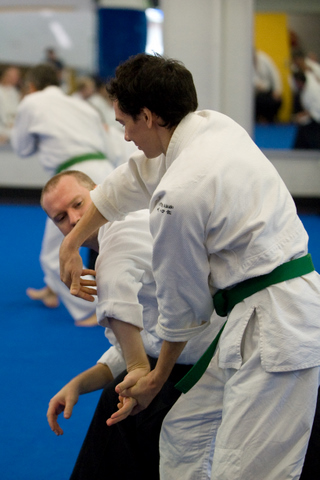Shukan News 6th February
BEGINNER’S COURSE STARTS THIS TUESDAY 7th FEBRUARY
If you have any contribution for the Shukan News (story, photograph, video), please send it via email to gary@garyweigh.com
1. Etiquette and bowing
This article, “Etiquette and Bowing” by Francis Takahashi, is reproduced from the Aikido Journal.
 Etiquette is a most useful tool to assist people of independent thinking, different cultural and ethnic origins, and for life tested individuals to suspend for the moment, their particular biases, beliefs and boundaries, for the good of harmonious and respectful social interaction with one another. The human species is the only one I am aware of that finds this to be useful and important.
Etiquette is a most useful tool to assist people of independent thinking, different cultural and ethnic origins, and for life tested individuals to suspend for the moment, their particular biases, beliefs and boundaries, for the good of harmonious and respectful social interaction with one another. The human species is the only one I am aware of that finds this to be useful and important.
Nonetheless, such standards of etiquette are at best, arbitrarily determined, culturally specific, and never intended to be an all inclusive invitation for anyone to join without condition or consequence. In other words, they are primarily designed to discriminate amongst potential participants in a specified social function or activity. You either comply with such standards, willingly or not, or be potentially ostracized and banished from further involvement with the specific privileges and activities defined by such arbitrary and inherently unfair boundaries of applied etiquette.
To read the entire article, follow the link:
http://blog.aikidojournal.com/2011/12/05/etiquette-and-bowing-by-francis-takahashi/
2. Consistency is the key to training
 Consistency of quality training is the key to competence and understanding in Aikido. The first requirement is to get to the dojo to practice. But if getting to the dojo means only being there in body and being switched off in mind, then progress will be slow.
Consistency of quality training is the key to competence and understanding in Aikido. The first requirement is to get to the dojo to practice. But if getting to the dojo means only being there in body and being switched off in mind, then progress will be slow.
The other relevant factor here is that not all dojos are the same. It helps a lot if the dojo you choose feels right for you. You are not going to want to train regularly inside a dojo that feels sterile and unwelcoming.
For example, you will know you are in the wrong place if you are ignored and left to your own devices as a beginner, or where the instructor has no interest in even knowing your name.
Secondly, Aikido is a mind-body art therefore quality training requires both mind and body to be present and focused. This is a discipline in itself because it is not always easy to juggle Aikido with the demands of a busy life outside the dojo.
Thirdly, practice should be performed at a level that is challenging and moves you outside of your comfort zone. Moving beyond that which you know is the way to progress along the path of Aikido.
Fourthly, Aikido training should be done on a regular basis. For most people, twice a week is the minimum, but training three times a week is desirable in order to move forward at a steady rate. Having said that, it is more important to decide on a level of commitment and stick to it. Sporadic training interspersed with long absences is a progress killer.
Lastly, it is important to realize that Aikido is a martial art that requires commitment to the art, to the dojo, to the instructors, and to fellow students. It is not a casual boxercise or pilates class, squeezed into your busy week when you have a spare hour or two.
It is rarely the beginner student showing most talent and potential who ultimately achieves black belt and beyond. More often it is the open minded, slower learner who embraces the art and commits to making Aikido a part of their life.
3. Taekwondo shuffle in Korea
This is an action packed 2:50 of fun and entertainment
http://www.youtube.com/watch?v=K1Cfy4d9-to&feature=related
4. Thought for the week
“Vision without action is a daydream. Action without vision is a nightmare.” Japanese proverb
